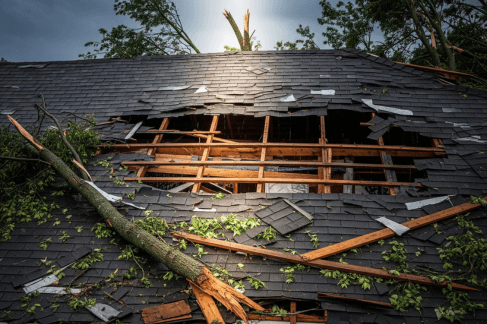Top Signs Your Orlando Home Needs Immediate Storm Damage Roof Repair

Orlando homeowners are no strangers to Florida’s intense weather patterns. From afternoon thunderstorms and heavy rains to tropical storms and hurricanes, roofs in Central Florida face constant wear and tear.
Even a single storm can cause significant damage—some of it obvious, some hidden. Ignoring early warning signs can lead to leaks, structural deterioration, mold growth, and costly repairs. Knowing what to look for can help you take action quickly and protect your home.
Here are the top signs your Orlando home may need immediate storm damage roof repair.
Missing or Damaged Shingles
One of the most common signs that you need to hire a contractor for storm damage roof repair in Orlando is missing or broken shingles. Strong winds, common in Orlando’s summer storms and hurricane season, can lift shingles or tear them off completely.
Look for:
- Shingles that are cracked, curled, or dented
- Exposed underlayment
- Bare roof patches
- Shingles scattered around your yard
Missing shingles leave your roof vulnerable to leaks and further water damage, especially during Florida’s heavy rainfall.
Water Leaks and Stains Inside the Home
If you notice water stains on your ceilings, walls, or around light fixtures, this is a major red flag. Storm damage often compromises the roof’s protective barrier, allowing rainwater to seep inside.
Common indicators include:
- Brown or yellow ceiling spots
- Peeling paint or bubbling drywall
- Damp attic insulation
- A musty odor coming from the attic
Even small leaks should be treated seriously. Water intrusion can spread quickly in humid Orlando conditions, causing mold growth and structural issues.
Granule Loss in Gutters or Around the Home
Asphalt shingles are coated with protective granules that shield them from sun and rain. Hail, heavy rain, and strong winds can knock these granules off.
Check your:
- Gutters
- Downspouts
- Driveway
- Yard areas near the roof line
If you notice piles of sand-like granules, your shingles may be worn out and more susceptible to future storms.
Dented or Cracked Roofing Materials
Hailstorms, which are not uncommon in Orlando during spring and summer, can leave dents and cracks on shingles, metal components, and flashing. However, if you notice the following signs, it indicates you need to invest in hail damage roof repair in Orlando:
- Circular dents in shingles
- Cracked or chipped tiles
- Bruised shingles that feel soft when pressed
- Damaged vents, flashing, or roof caps
These issues may not cause immediate leaks but can significantly shorten your roof’s lifespan if not repaired promptly.
Loose, Damaged, or Missing Flashing
Flashing is used around chimneys, vents, skylights, and edges to keep water out. High winds and heavy rain can loosen or damage these areas.
Check for:
- Gaps around chimneys
- Bent or lifted flashing
- Rusted metal
- Loose sealant
Flashing issues often lead to hidden leaks—especially after extended periods of rainfall.
Sagging Roof Sections
A sagging roof is a serious structural concern and may indicate severe water damage, deterioration, or weakened decking beneath the surface.
If you notice:
- Uneven roof lines
- Dipping areas
- Visible sag from the street
You should contact a roofing professional immediately. Orlando’s frequent downpours can quickly worsen sagging areas.
Mold or Mildew Growth
Florida’s high humidity makes homes especially vulnerable to mold growth after a storm. If your roof has been compromised, moisture can accumulate in the attic or walls.
Watch for:
- A musty smell
- Black or green spots near vents or ceilings
- Visible mold in the attic
Mold grows rapidly in Orlando’s climate and can pose health risks if not addressed quickly.
Increased Energy Bills
Damage to your roof can affect your home’s insulation and ventilation. If warm air enters through compromised roofing materials, your air conditioning system must work harder—leading to higher energy bills.
If you notice sudden spikes in cooling costs after a storm, roof damage may be the culprit.
Debris on the Roof
Storms often leave behind debris such as branches, leaves, or even fallen trees. Heavy debris can damage shingles, puncture roofing materials, or clog drainage pathways.
If you see:
- Branches embedded in the roof
- Large debris on the surface
- Gutters overflowing with leaves
You may need immediate roof repair to prevent additional problems.
Damage Around Skylights, Soffits, and Fascia
Storm winds can loosen or damage areas connected to the roof structure. Inspect the exterior of your home for signs of impact.
Look for:
- Cracked or loose skylights
- Damaged soffits or fascia boards
- Water stains around edges
These areas often indicate roof system compromise, especially during storms with heavy wind-driven rain.
Light Shining Through Your Attic
If you go into your attic during daylight and see streams of light penetrating through the roof boards, this means there are gaps or holes caused by storm damage.
This is a sign of:
- Broken shingles
- Punctured decking
- Poor sealing after wind uplift
Even small openings can lead to major water intrusion during the next storm.
Final Thoughts
Orlando’s stormy climate makes roof maintenance essential for every homeowner. Storm damage is not always obvious, and even minor issues can worsen rapidly due to Florida’s heat and humidity. If you notice any of these warning signs, it’s important to seek professional roof repair as soon as possible. Timely repairs protect your home from structural issues, mold, and costly future damage.
By addressing storm damage early, you ensure your Orlando home stays safe, secure, and ready to weather the next Florida storm season.
For More Info Visit:- articlepoint.org

Comments are closed.